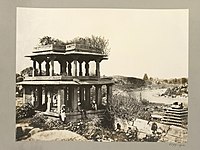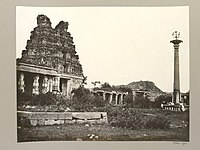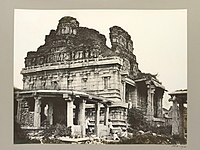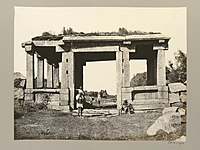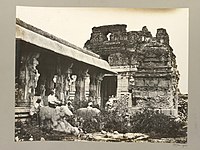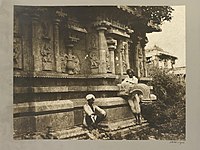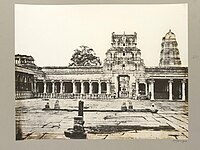Alexander Greenlaw
| Alexander Greenlaw | |
|---|---|
| Narození | 1818 |
| Úmrtí | 1870 (ve věku 51–52 let) |
| Povolání | fotograf |
| Některá data mohou pocházet z datové položky. Chybí svobodný obrázek. | |

John Alexander Greenlaw (1818–1870) byl amatérský britský koloniální fotograf. Je známý tím, že pořídil nejstarší známé fotografie Hampi, oblasti Vijayanagara, která se později stala součástí světového dědictví UNESCO.
Vijayanagara
Alexander Greenlaw byl prvním, kdo v roce 1855 Vijayanagaru rozsáhle fotografoval.[1] V únoru 1856 se zúčastnil Madrasské výstavy surovin, umění a výroby v jižní Indii, kde vystavil fotografie dříve nefotografovaných chrámů. Porota jeho fotografie velmi cenila.[2][3] Komentář ve zprávě poroty zaznamenal umělecké kvality v jeho dílech:
...Z povahy fotografie by se dalo předpokládat, že všechny obrazy vytvořené jejími prostředky musí mít stylovou podobnost; je však zvláštní fakt, že tomu tak není, práce jednoho operátora se svým charakterem dokonale liší od práce druhého, i když byl použit stejný typ zařízení a stejný proces; to lze pozorovat, když dva obrázky byly pořízeny různými vystavovateli ze stejného pohledu – nejlepší indické fotografie na výstavě, ty od kpt. Linnaa Tripeho a kpt. Greenlawa, to dokládají výrazným způsobem. Pohledy kpt. Tripeho vynikají povrchovou úpravou a jemností – ty od kapitána Greenlawa ve smělosti, svobodě a efektu, první jsou možná nejlepší fotografie, ale ty druhé jsou nejlepší obrazy. Kalotypie pořízené v Barmě a vystavené kpt. Tripem jsou výborné; pozoruhodné pro velkou odlišnost a také pro svůj neobvyklý a krásný odstín. Když jsou všechny tak skvělé, je těžké označit některé za zvlášť hodné povšimnutí."
Vijayanagara, což znamená město vítězství, bylo císařským hlavním městem poslední velké hinduistické říše, která vládla jižní Indii. Vijayanagarská říše, založená v roce 1336 a pojmenovaná po svém hlavním městě, expandovala a prosperovala v průběhu příštího století. V roce 1565 bylo toto impozantní město vypleněno armádami dekánských sultanátů a nikdy nebylo obnoveno. Tato lokalita nyní známá jako „Skupina památek v Hampi“ představuje nejlepší a nejvyšší koncentraci architektury v říši.[1]
Amatérský britský koloniální fotograf Alexander Greenlaw byl prvním, kdo toto místo rozsáhle vyfotografoval v letech 1855-1856. Výsledná série negativů z voskovaného papíru byla dána k dispozici muzeu Victoria and Albert Museum a vytištěna v roce 1910. Toto jsou nejstarší známé tisky.[1]
Victoria and Albert Museum uchovává 61 výtisků Vijayanagaru a 5 různých výtisků (anglo-indická architektura v Bellary a indická studia stromů) od Greenlawa. Tyto tisky byly speciálně vyrobeny v roce 1910 pro sbírku muzea z původních negativů z roku 1856, které muzeu zapůjčila paní Armitage z East Sheenu. Z těchto 66 tisků je 45 aktuálně uloženo v asijském oddělení a 21 v oddělení slova a obrazu.[1]
Negativy spolu s dalším souborem tisků, také vyrobených v roce 1910, byly „znovu objeveny“ v soukromé sbírce v roce 1980. V roce 1983 sběratel Edgar Gibbons, penzionovaný armádní důstojník z Cornwallu, nedávno koupil negativy a tisky od příbuzných Greenlawa, zpřístupnil negativy fotografovi projektu Vijayanagara Research Project Johnu Gollingsovi. Gollings vytvořil dvě nové sady tisků, z nichž jednu poslal sběrateli a jednu si ponechal. Sběratelské originální negativy a tisky z roku 1910 následně zakoupila Alkazi Foundation.[1]
Nadace Alkazi v současné době vlastní duplikát s tou výjimkou, že Alkazi nemá čísla 3795-1910 (Alkazi drží negativ tohoto snímku) a 3784-1910. Gollings daroval svou sadu z roku 1983 Kanadskému centru architektury (CCA) spolu se sérií vlastních fotografií. Gollings, fascinován Greenlawovými snímky, v roce 1983 pečlivě přefotografoval šedesát přesných míst, která Greenlaw navštívil. To mělo umožnit Výzkumnému projektu Vijayanagara posoudit změnu stavu památek v průběhu času.[1]
Galerie
Chrám avatara Narasimha, 1856
Chrámový komplex Vitthala, 1856
Krišnův chrámový komplex, 1856
Pavilón na hoře Hemakuta, 1856
Malapannagudi, 1856
Krišnův chrám v Hampi, oblast Vijayanagara, UNESCO, 1855–1856
Krišnův chrám v Hampi, oblast Vijayanagara, UNESCO, 1855–1856
Chrámový komplex Ramachandra, 1856
Chrám Virupaksha, 1856
Odkazy
Reference
- ↑ a b c d e f MUSEUM, Victoria and Albert. Hampi (Vijayanagar) Bellary District: Gateway and Pavilion at Hemakuta Hill. | Greenlaw, Alexander John (Colonel) | V&A Explore The Collections. Victoria and Albert Museum: Explore the Collections [online]. [cit. 2022-11-06]. Dostupné online. (anglicky)
- ↑ Report of the Juries. Madras: [s.n.], 1856. Dostupné online. S. 124. (anglicky)
- ↑ Madras Exhibition of Raw Products, Arts, and Manufactures of Southern India. Reports by the juries on the subjects in the thirty classes into which the exhibition was divided.. Madras: [s.n.], 1856. Dostupné online. S. 187. (anglicky)
Související články
Další významní fotografové 19. století v Barmě:
Externí odkazy
 Obrázky, zvuky či videa k tématu Alexander Greenlaw na Wikimedia Commons
Obrázky, zvuky či videa k tématu Alexander Greenlaw na Wikimedia Commons
Média použitá na této stránce
According to V&A Museum source details standard for the Greenlaw 1856 collection of Hampi photographs:
Vijayanagara, meaning city of victory was the imperial capital of the last great Hindu empire to rule south India. Established in 1336 and named after its capital, the Vijayanagara empire expanded and prospered throughout the next century. In 1565, this impressive city was sacked by armies from the Deccan sultanates and never rebuilt. Now known as the ‘Group of Monuments at Hampi’, the site represents the empire’s finest and highest concentration of architecture.
Amateur British colonial photographer, Alexander Greenlaw was the first to extensively photograph the site in 1855-56. The resulting series of waxed paper negatives were made available to the V&A and printed in 1910. These are the earliest known prints.
The V&A holds 61 prints of Vijayanagar and 5 miscellaneous prints (Anglo-Indian architecture in Bellary and Indian tree studies) by Greenlaw. These prints were specially made in 1910 for the V&A collection from the original 1856 negatives which were lent to the museum by Mrs Armitage of East Sheen. Of these 66 prints, 45 are currently held in the Asian Dept and 21 in the Word and Image Dept.
The negatives along with another set of prints, also made in 1910, were 'rediscovered' in a private collection in 1980. In 1983, the collector, Edgar Gibbons, a retired Army officer from Cornwall, having recently purchased the negatives and prints from a relative of Greenlaw, made the negatives available to the Vijayanagara Research Project photographer, John Gollings. Gollings made two new sets of prints, one of which he sent to the collector and one of which he kept. The collector's original negatives and 1910 prints were subsequently purchased by the Alkazi Foundation.
The Alkazi Foundation currently holds a duplicate set with the exception that the Alkazi does not hold No’s 3795-1910 (Alkazi holds the negative for this image) and 3784-1910.
Gollings donated his 1983 set to the Canadian Centre for Architecture (CCA) along with a series of his own photographs. Fascinated by Greenlaw’s images, Gollings painstakingly rephotographed, in 1983, sixty of the exact sites visited by Greenlaw. This was to enable the Vijayanagara Research Project to measure the change in the condition of the monuments over time.According to V&A Museum source details standard for the Greenlaw 1856 collection of Hampi photographs:
Vijayanagara, meaning city of victory was the imperial capital of the last great Hindu empire to rule south India. Established in 1336 and named after its capital, the Vijayanagara empire expanded and prospered throughout the next century. In 1565, this impressive city was sacked by armies from the Deccan sultanates and never rebuilt. Now known as the ‘Group of Monuments at Hampi’, the site represents the empire’s finest and highest concentration of architecture.
Amateur British colonial photographer, Alexander Greenlaw was the first to extensively photograph the site in 1855-56. The resulting series of waxed paper negatives were made available to the V&A and printed in 1910. These are the earliest known prints.
The V&A holds 61 prints of Vijayanagar and 5 miscellaneous prints (Anglo-Indian architecture in Bellary and Indian tree studies) by Greenlaw. These prints were specially made in 1910 for the V&A collection from the original 1856 negatives which were lent to the museum by Mrs Armitage of East Sheen. Of these 66 prints, 45 are currently held in the Asian Dept and 21 in the Word and Image Dept.
The negatives along with another set of prints, also made in 1910, were 'rediscovered' in a private collection in 1980. In 1983, the collector, Edgar Gibbons, a retired Army officer from Cornwall, having recently purchased the negatives and prints from a relative of Greenlaw, made the negatives available to the Vijayanagara Research Project photographer, John Gollings. Gollings made two new sets of prints, one of which he sent to the collector and one of which he kept. The collector's original negatives and 1910 prints were subsequently purchased by the Alkazi Foundation.
The Alkazi Foundation currently holds a duplicate set with the exception that the Alkazi does not hold No’s 3795-1910 (Alkazi holds the negative for this image) and 3784-1910.
Gollings donated his 1983 set to the Canadian Centre for Architecture (CCA) along with a series of his own photographs. Fascinated by Greenlaw’s images, Gollings painstakingly rephotographed, in 1983, sixty of the exact sites visited by Greenlaw. This was to enable the Vijayanagara Research Project to measure the change in the condition of the monuments over time.According to V&A Museum source details standard for the Greenlaw 1856 collection of Hampi photographs:
Vijayanagara, meaning city of victory was the imperial capital of the last great Hindu empire to rule south India. Established in 1336 and named after its capital, the Vijayanagara empire expanded and prospered throughout the next century. In 1565, this impressive city was sacked by armies from the Deccan sultanates and never rebuilt. Now known as the ‘Group of Monuments at Hampi’, the site represents the empire’s finest and highest concentration of architecture.
Amateur British colonial photographer, Alexander Greenlaw was the first to extensively photograph the site in 1855-56. The resulting series of waxed paper negatives were made available to the V&A and printed in 1910. These are the earliest known prints.
The V&A holds 61 prints of Vijayanagar and 5 miscellaneous prints (Anglo-Indian architecture in Bellary and Indian tree studies) by Greenlaw. These prints were specially made in 1910 for the V&A collection from the original 1856 negatives which were lent to the museum by Mrs Armitage of East Sheen. Of these 66 prints, 45 are currently held in the Asian Dept and 21 in the Word and Image Dept.
The negatives along with another set of prints, also made in 1910, were 'rediscovered' in a private collection in 1980. In 1983, the collector, Edgar Gibbons, a retired Army officer from Cornwall, having recently purchased the negatives and prints from a relative of Greenlaw, made the negatives available to the Vijayanagara Research Project photographer, John Gollings. Gollings made two new sets of prints, one of which he sent to the collector and one of which he kept. The collector's original negatives and 1910 prints were subsequently purchased by the Alkazi Foundation.
The Alkazi Foundation currently holds a duplicate set with the exception that the Alkazi does not hold No’s 3795-1910 (Alkazi holds the negative for this image) and 3784-1910.
Gollings donated his 1983 set to the Canadian Centre for Architecture (CCA) along with a series of his own photographs. Fascinated by Greenlaw’s images, Gollings painstakingly rephotographed, in 1983, sixty of the exact sites visited by Greenlaw. This was to enable the Vijayanagara Research Project to measure the change in the condition of the monuments over time.According to V&A Museum source details standard for the Greenlaw 1856 collection of Hampi photographs:
Vijayanagara, meaning city of victory was the imperial capital of the last great Hindu empire to rule south India. Established in 1336 and named after its capital, the Vijayanagara empire expanded and prospered throughout the next century. In 1565, this impressive city was sacked by armies from the Deccan sultanates and never rebuilt. Now known as the ‘Group of Monuments at Hampi’, the site represents the empire’s finest and highest concentration of architecture.
Amateur British colonial photographer, Alexander Greenlaw was the first to extensively photograph the site in 1855-56. The resulting series of waxed paper negatives were made available to the V&A and printed in 1910. These are the earliest known prints.
The V&A holds 61 prints of Vijayanagar and 5 miscellaneous prints (Anglo-Indian architecture in Bellary and Indian tree studies) by Greenlaw. These prints were specially made in 1910 for the V&A collection from the original 1856 negatives which were lent to the museum by Mrs Armitage of East Sheen. Of these 66 prints, 45 are currently held in the Asian Dept and 21 in the Word and Image Dept.
The negatives along with another set of prints, also made in 1910, were 'rediscovered' in a private collection in 1980. In 1983, the collector, Edgar Gibbons, a retired Army officer from Cornwall, having recently purchased the negatives and prints from a relative of Greenlaw, made the negatives available to the Vijayanagara Research Project photographer, John Gollings. Gollings made two new sets of prints, one of which he sent to the collector and one of which he kept. The collector's original negatives and 1910 prints were subsequently purchased by the Alkazi Foundation.
The Alkazi Foundation currently holds a duplicate set with the exception that the Alkazi does not hold No’s 3795-1910 (Alkazi holds the negative for this image) and 3784-1910.
Gollings donated his 1983 set to the Canadian Centre for Architecture (CCA) along with a series of his own photographs. Fascinated by Greenlaw’s images, Gollings painstakingly rephotographed, in 1983, sixty of the exact sites visited by Greenlaw. This was to enable the Vijayanagara Research Project to measure the change in the condition of the monuments over time.According to V&A Museum source details standard for the Greenlaw 1856 collection of Hampi photographs:
Vijayanagara, meaning city of victory was the imperial capital of the last great Hindu empire to rule south India. Established in 1336 and named after its capital, the Vijayanagara empire expanded and prospered throughout the next century. In 1565, this impressive city was sacked by armies from the Deccan sultanates and never rebuilt. Now known as the ‘Group of Monuments at Hampi’, the site represents the empire’s finest and highest concentration of architecture.
Amateur British colonial photographer, Alexander Greenlaw was the first to extensively photograph the site in 1855-56. The resulting series of waxed paper negatives were made available to the V&A and printed in 1910. These are the earliest known prints.
The V&A holds 61 prints of Vijayanagar and 5 miscellaneous prints (Anglo-Indian architecture in Bellary and Indian tree studies) by Greenlaw. These prints were specially made in 1910 for the V&A collection from the original 1856 negatives which were lent to the museum by Mrs Armitage of East Sheen. Of these 66 prints, 45 are currently held in the Asian Dept and 21 in the Word and Image Dept.
The negatives along with another set of prints, also made in 1910, were 'rediscovered' in a private collection in 1980. In 1983, the collector, Edgar Gibbons, a retired Army officer from Cornwall, having recently purchased the negatives and prints from a relative of Greenlaw, made the negatives available to the Vijayanagara Research Project photographer, John Gollings. Gollings made two new sets of prints, one of which he sent to the collector and one of which he kept. The collector's original negatives and 1910 prints were subsequently purchased by the Alkazi Foundation.
The Alkazi Foundation currently holds a duplicate set with the exception that the Alkazi does not hold No’s 3795-1910 (Alkazi holds the negative for this image) and 3784-1910.
Gollings donated his 1983 set to the Canadian Centre for Architecture (CCA) along with a series of his own photographs. Fascinated by Greenlaw’s images, Gollings painstakingly rephotographed, in 1983, sixty of the exact sites visited by Greenlaw. This was to enable the Vijayanagara Research Project to measure the change in the condition of the monuments over time.According to V&A Museum source details standard for the Greenlaw 1856 collection of Hampi photographs:
Vijayanagara, meaning city of victory was the imperial capital of the last great Hindu empire to rule south India. Established in 1336 and named after its capital, the Vijayanagara empire expanded and prospered throughout the next century. In 1565, this impressive city was sacked by armies from the Deccan sultanates and never rebuilt. Now known as the ‘Group of Monuments at Hampi’, the site represents the empire’s finest and highest concentration of architecture.
Amateur British colonial photographer, Alexander Greenlaw was the first to extensively photograph the site in 1855-56. The resulting series of waxed paper negatives were made available to the V&A and printed in 1910. These are the earliest known prints.
The V&A holds 61 prints of Vijayanagar and 5 miscellaneous prints (Anglo-Indian architecture in Bellary and Indian tree studies) by Greenlaw. These prints were specially made in 1910 for the V&A collection from the original 1856 negatives which were lent to the museum by Mrs Armitage of East Sheen. Of these 66 prints, 45 are currently held in the Asian Dept and 21 in the Word and Image Dept.
The negatives along with another set of prints, also made in 1910, were 'rediscovered' in a private collection in 1980. In 1983, the collector, Edgar Gibbons, a retired Army officer from Cornwall, having recently purchased the negatives and prints from a relative of Greenlaw, made the negatives available to the Vijayanagara Research Project photographer, John Gollings. Gollings made two new sets of prints, one of which he sent to the collector and one of which he kept. The collector's original negatives and 1910 prints were subsequently purchased by the Alkazi Foundation.
The Alkazi Foundation currently holds a duplicate set with the exception that the Alkazi does not hold No’s 3795-1910 (Alkazi holds the negative for this image) and 3784-1910.
Gollings donated his 1983 set to the Canadian Centre for Architecture (CCA) along with a series of his own photographs. Fascinated by Greenlaw’s images, Gollings painstakingly rephotographed, in 1983, sixty of the exact sites visited by Greenlaw. This was to enable the Vijayanagara Research Project to measure the change in the condition of the monuments over time.According to V&A Museum source details standard for the Greenlaw 1856 collection of Hampi photographs:
Vijayanagara, meaning city of victory was the imperial capital of the last great Hindu empire to rule south India. Established in 1336 and named after its capital, the Vijayanagara empire expanded and prospered throughout the next century. In 1565, this impressive city was sacked by armies from the Deccan sultanates and never rebuilt. Now known as the ‘Group of Monuments at Hampi’, the site represents the empire’s finest and highest concentration of architecture.
Amateur British colonial photographer, Alexander Greenlaw was the first to extensively photograph the site in 1855-56. The resulting series of waxed paper negatives were made available to the V&A and printed in 1910. These are the earliest known prints.
The V&A holds 61 prints of Vijayanagar and 5 miscellaneous prints (Anglo-Indian architecture in Bellary and Indian tree studies) by Greenlaw. These prints were specially made in 1910 for the V&A collection from the original 1856 negatives which were lent to the museum by Mrs Armitage of East Sheen. Of these 66 prints, 45 are currently held in the Asian Dept and 21 in the Word and Image Dept.
The negatives along with another set of prints, also made in 1910, were 'rediscovered' in a private collection in 1980. In 1983, the collector, Edgar Gibbons, a retired Army officer from Cornwall, having recently purchased the negatives and prints from a relative of Greenlaw, made the negatives available to the Vijayanagara Research Project photographer, John Gollings. Gollings made two new sets of prints, one of which he sent to the collector and one of which he kept. The collector's original negatives and 1910 prints were subsequently purchased by the Alkazi Foundation.
The Alkazi Foundation currently holds a duplicate set with the exception that the Alkazi does not hold No’s 3795-1910 (Alkazi holds the negative for this image) and 3784-1910.
Gollings donated his 1983 set to the Canadian Centre for Architecture (CCA) along with a series of his own photographs. Fascinated by Greenlaw’s images, Gollings painstakingly rephotographed, in 1983, sixty of the exact sites visited by Greenlaw. This was to enable the Vijayanagara Research Project to measure the change in the condition of the monuments over time.According to V&A Museum source details standard for the Greenlaw 1856 collection of Hampi photographs:
Vijayanagara, meaning city of victory was the imperial capital of the last great Hindu empire to rule south India. Established in 1336 and named after its capital, the Vijayanagara empire expanded and prospered throughout the next century. In 1565, this impressive city was sacked by armies from the Deccan sultanates and never rebuilt. Now known as the ‘Group of Monuments at Hampi’, the site represents the empire’s finest and highest concentration of architecture.
Amateur British colonial photographer, Alexander Greenlaw was the first to extensively photograph the site in 1855-56. The resulting series of waxed paper negatives were made available to the V&A and printed in 1910. These are the earliest known prints.
The V&A holds 61 prints of Vijayanagar and 5 miscellaneous prints (Anglo-Indian architecture in Bellary and Indian tree studies) by Greenlaw. These prints were specially made in 1910 for the V&A collection from the original 1856 negatives which were lent to the museum by Mrs Armitage of East Sheen. Of these 66 prints, 45 are currently held in the Asian Dept and 21 in the Word and Image Dept.
The negatives along with another set of prints, also made in 1910, were 'rediscovered' in a private collection in 1980. In 1983, the collector, Edgar Gibbons, a retired Army officer from Cornwall, having recently purchased the negatives and prints from a relative of Greenlaw, made the negatives available to the Vijayanagara Research Project photographer, John Gollings. Gollings made two new sets of prints, one of which he sent to the collector and one of which he kept. The collector's original negatives and 1910 prints were subsequently purchased by the Alkazi Foundation.
The Alkazi Foundation currently holds a duplicate set with the exception that the Alkazi does not hold No’s 3795-1910 (Alkazi holds the negative for this image) and 3784-1910.
Gollings donated his 1983 set to the Canadian Centre for Architecture (CCA) along with a series of his own photographs. Fascinated by Greenlaw’s images, Gollings painstakingly rephotographed, in 1983, sixty of the exact sites visited by Greenlaw. This was to enable the Vijayanagara Research Project to measure the change in the condition of the monuments over time.According to V&A Museum source details standard for the Greenlaw 1856 collection of Hampi photographs:
Vijayanagara, meaning city of victory was the imperial capital of the last great Hindu empire to rule south India. Established in 1336 and named after its capital, the Vijayanagara empire expanded and prospered throughout the next century. In 1565, this impressive city was sacked by armies from the Deccan sultanates and never rebuilt. Now known as the ‘Group of Monuments at Hampi’, the site represents the empire’s finest and highest concentration of architecture.
Amateur British colonial photographer, Alexander Greenlaw was the first to extensively photograph the site in 1855-56. The resulting series of waxed paper negatives were made available to the V&A and printed in 1910. These are the earliest known prints.
The V&A holds 61 prints of Vijayanagar and 5 miscellaneous prints (Anglo-Indian architecture in Bellary and Indian tree studies) by Greenlaw. These prints were specially made in 1910 for the V&A collection from the original 1856 negatives which were lent to the museum by Mrs Armitage of East Sheen. Of these 66 prints, 45 are currently held in the Asian Dept and 21 in the Word and Image Dept.
The negatives along with another set of prints, also made in 1910, were 'rediscovered' in a private collection in 1980. In 1983, the collector, Edgar Gibbons, a retired Army officer from Cornwall, having recently purchased the negatives and prints from a relative of Greenlaw, made the negatives available to the Vijayanagara Research Project photographer, John Gollings. Gollings made two new sets of prints, one of which he sent to the collector and one of which he kept. The collector's original negatives and 1910 prints were subsequently purchased by the Alkazi Foundation.
The Alkazi Foundation currently holds a duplicate set with the exception that the Alkazi does not hold No’s 3795-1910 (Alkazi holds the negative for this image) and 3784-1910.
Gollings donated his 1983 set to the Canadian Centre for Architecture (CCA) along with a series of his own photographs. Fascinated by Greenlaw’s images, Gollings painstakingly rephotographed, in 1983, sixty of the exact sites visited by Greenlaw. This was to enable the Vijayanagara Research Project to measure the change in the condition of the monuments over time.According to V&A Museum source details standard for the Greenlaw 1856 collection of Hampi photographs:
Vijayanagara, meaning city of victory was the imperial capital of the last great Hindu empire to rule south India. Established in 1336 and named after its capital, the Vijayanagara empire expanded and prospered throughout the next century. In 1565, this impressive city was sacked by armies from the Deccan sultanates and never rebuilt. Now known as the ‘Group of Monuments at Hampi’, the site represents the empire’s finest and highest concentration of architecture.
Amateur British colonial photographer, Alexander Greenlaw was the first to extensively photograph the site in 1855-56. The resulting series of waxed paper negatives were made available to the V&A and printed in 1910. These are the earliest known prints.
The V&A holds 61 prints of Vijayanagar and 5 miscellaneous prints (Anglo-Indian architecture in Bellary and Indian tree studies) by Greenlaw. These prints were specially made in 1910 for the V&A collection from the original 1856 negatives which were lent to the museum by Mrs Armitage of East Sheen. Of these 66 prints, 45 are currently held in the Asian Dept and 21 in the Word and Image Dept.
The negatives along with another set of prints, also made in 1910, were 'rediscovered' in a private collection in 1980. In 1983, the collector, Edgar Gibbons, a retired Army officer from Cornwall, having recently purchased the negatives and prints from a relative of Greenlaw, made the negatives available to the Vijayanagara Research Project photographer, John Gollings. Gollings made two new sets of prints, one of which he sent to the collector and one of which he kept. The collector's original negatives and 1910 prints were subsequently purchased by the Alkazi Foundation.
The Alkazi Foundation currently holds a duplicate set with the exception that the Alkazi does not hold No’s 3795-1910 (Alkazi holds the negative for this image) and 3784-1910.
Gollings donated his 1983 set to the Canadian Centre for Architecture (CCA) along with a series of his own photographs. Fascinated by Greenlaw’s images, Gollings painstakingly rephotographed, in 1983, sixty of the exact sites visited by Greenlaw. This was to enable the Vijayanagara Research Project to measure the change in the condition of the monuments over time.